A Time-Delayed Mathematical Model for Tumor Growth with the Effect of a Periodic Therapy
Abstract
A time-delayed mathematical model for tumor growth with the effect of periodic therapy is studied. The establishment of the model is based on the reaction-diffusion dynamics and mass conservation law and is considered with a time delay in cell proliferation process. Sufficient conditions for the global stability of tumor free equilibrium are given. We also prove that if external concentration of nutrients is large the tumor will not disappear and the conditions under which there exist periodic solutions to the model are also determined. Results are illustrated by computer simulations.
1. Introduction
The process of tumor growth is one of the most intensively studied processes in recent years. There have appeared many papers devoted to develop mathematical models to describe the process (see, e.g., [1–8]). Most of those models are based on the reaction-diffusion equations and mass conservation law. The process of tumor growth has several different stages, starting from the very early stage of solid tumor without necrotic core inside (see, e.g., [2, 9–12]) to the process of necrotic core formation (see, e.g., [3, 13–15]). Experiments suggest that changes in the proliferation rate can trigger changes in apoptotic cell loss and that these changes do not occur instantaneously: they are mediated by growth factors expressed by the tumor cells (see [13]). Following this idea, the study of time-delayed mathematical model for tumor growth has drawn attention of some other researchers (see, e.g., [6, 11, 16–18] and references cited therein).
- (i)
σ(r, t): the nutrient concentration at radius r and time t,
- (ii)
R(t): the outer tumor radius at time t.
The idea of considering the effect of periodic therapy is motivated by [17]. In [17], through experiments, the authors observed that after an initial exponential growth phase leading to tumor expansion, growth saturation is observed even in the presence of periodically external condition. In this paper, we mainly discuss how the periodic therapy affects the growth of the avascular tumor. The model studied in this paper is similar to the first model studied in [11] and the model discussed in [19], but with some modifications. In [11, 19], the authors only consider the special cases of the model. In [11], the authors consider the case where λ(t) ≡ 0 and in [19], the author considers the case where τ = 0. In this paper, we will consider the general model in which τ > 0 and λ(t) is a periodic function. It should be pointed out that the methods used in [11, 19] are no longer applicable. In this paper, by the fixed point index theorem, the conditions under which there exist periodic solutions to the model are determined. Using the comparison principle, sufficient conditions for the global stability of tumor free equilibrium are given. Results are illustrated by computer simulations.
2. Analytical Results
Since f(x) ≥ 0 for all x ≥ 0, then, by Theorem 1.1 [20], we have the solution of problem (11), (12) being nonnegative on the interval on which it exists.
In order to prove our results, we should use the following Lemma from [11].
Lemma 1 (see [11].)Consider the initial value problem of a delay differential equation:
- (1)
If xs is a positive solution of equation g(x, x) = 0 such that g(x, x) > 0 for x less than but near xs, g(x, x) < 0 for x greater than but near xs. Let (c, d) be the maximal interval containing only the root xs of equation g(x, x) = 0. If x(t) is the solution of the problem of (14) and x0(t) ∈ C[−τ, 0], c < x0(t) < d for −τ ≤ t ≤ 0. Then
(15) - (2)
Assume further that g(x, x) is negative for small x > 0, and let b be the first positive root of the equation g(x, x) = 0 (if g(x, x) < 0 for all x > 0, then we define b = ∞). If x0(t)∈(0, b) for all −τ ≤ t ≤ 0 and the solution to (14) exists for all t ≥ −τ, then
(16)
Lemma 2. (1) p(x) is monotone decreasing for all x > 0 and
(2) x3p(x) is monotone increasing for all x > 0.
Lemma 3. If λ ≡ λ0, where λ0 is a positive constant, the following assertions hold:
- (1)
If , (11) has a unique positive stationary point xs which is determined by If , (11) has no positive stationary solution.
- (2)
If , all solutions of (11) which are positive in the initial interval [−τ, 0] exist for all t ≥ −τ and converge to xs as t → ∞. If , then all solutions of (11) which are positive in [−τ, 0] also exist for all t ≥ −τ and they converge to zero as t → ∞.
Proof. (1) If λ ≡ λ0, where λ0 is a positive constant, that is, , then the stationary solutions of (11) satisfy the following equation:
(2) Set ; then . By simple computation
By monotonicity of the function p and Lemma 3(1), we can get the following: if , then g(x, x) > 0 for x < xs; g(x, x) < 0 for x > xs. By Lemma 1(1), for any nonnegative initial function x0(t), the following holds:
In Figure 1, an example of the graph of xs(λ0) is presented which is covered by Lemma 3(1), where σ∞ = 5 and .
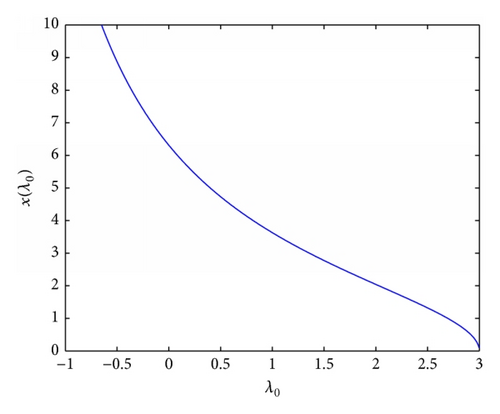
Theorem 4. (i) If , then, for any nonnegative initial function x(t), there exists T > 0 such that the unique solution x(t) to (11), (12) satisfies x(t)∈[x1/2, 3x2/2] for t ≥ T.
(ii) If , then, for any nonnegative initial function x(t), the unique solution x(t) to (11), (12) satisfies limt→∞x(t) = 0.
Proof. (i) By (11), one can get
Since g(x, x) = f2(x) and
(ii) The proof is similar to that of Lemma 3(2) by considering (28); we omit it here. This completes the proof of Theorem 4.
Remark 5. Note that x1 and x2 are decreasing function of λ∗ and λ∗, respectively; one can easily get that when λ∗ − λ∗ decreases, 3x2/2 − x1/2 will decrease; that is, the interval [x1/2, 3x2/2] will be reduced.
In the following, we will give some results that (11) admits an oscillatory solution whose period matches that of λ(t).
Let
It is easy to see that (11) admits oscillatory solutions whose period matches that of λ(t) if and only if (36) has ω-periodic solutions. Further, one can get
Define an operator A : X → X by
Lemma 6. (1) A(K) ⊂ K and A : X → X is a completely continuous operator.
(2) If there exists ε > 0 such that f(x(t)) ≤ εx(t) for x ∈ K, t ∈ [0, ω], then
Proof. (1) By direct computation, for x ∈ K ⊂ X,
Moreover, for x ∈ K ⊂ X and t ∈ [0, ω], one can get
Next, we prove that A : X → X is a compact operator. Since
(2) If there exists ε > 0 such that f(x(t)) ≤ εx(t) for x ∈ K, t ∈ [0, ω], by definition of (Ax)(t), one can get
Lemma 7 (see [21]–[23].)Let E be a Banach space and K is a cone in E. For r > 0, Ωr = {x ∈ K : ‖x‖ < r}. Assume that is completely continuous operator such that Au ≠ u for u ∈ ∂Ωr = {x ∈ K : ‖x‖ = r}. Then we have the following:
- (I)
If ‖Au‖ ≥ u for u ∈ ∂Ωr, then i(A, Ωr, K) = 0.
- (II)
If ‖Au‖ ≤ u for u ∈ ∂Ωr, then i(A, Ωr, K) = 1.
Theorem 8. Equation (11) has at least one positive ω-periodic solution for .
Proof. From definition of operator A, we can see that (11) admits oscillatory solutions whose period matches that of λ(t) (i.e., whose period is ω) if and only if A has fixed points.
For r > 0, define Ωr = {x ∈ K : ‖x‖ < r} and ∂Ωr = {x ∈ K : ‖x‖ = r}. If x ∈ ∂Ωr, let
Since
3. Computer Simulations and Conclusions
In this paper a mathematical model for a solid avascular tumor growth under the effect periodic therapy with time delays in proliferation is studied. The periodic therapy can be interpreted as a treatment and λ(t) describes the rate of cell apoptosis caused by the periodic therapy. We mainly study how the periodic therapy influences the growth of tumors. We have derived a sufficient condition for the global stability of tumor free equilibrium and proved the existence of a periodic solution under some conditions. We also prove that if external concentration of nutrients is large the tumor will not disappear and the condition under which there exist periodic solutions to the model is determined. Hence, in biology sense, the results have practical significance in terms of determining the amount of drug required to eliminate the tumor and tell us that the tumor may grow in a periodic way under some conditions.
In [11, 19], the authors have studied the special cases of the model. In [11], the authors consider the case when λ(t) ≡ 0, and the results show that the tumor radius will tend to zero or tend to a stationary version. In [19], the author considers the case when τ = 0 and the result shows that the tumor radius will tend to zero or tend to a periodic version. From the analysis, we can see that the periodic therapy makes the tumor growth more complicated.
By using Matlab 7.1, we present some examples of solutions of (11) for different parameter values (see Figures 2–8). For all simulations, the values used in simulations are given with the figures’ captions.
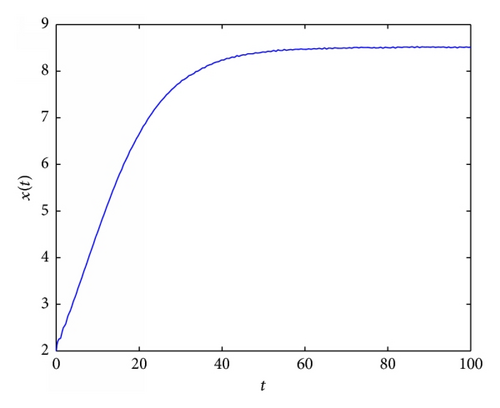
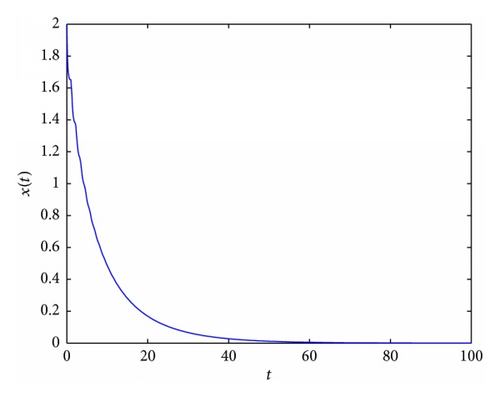
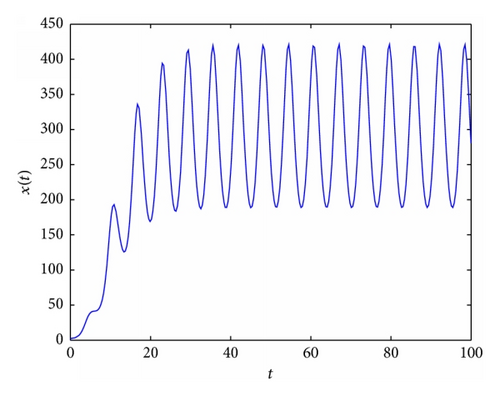
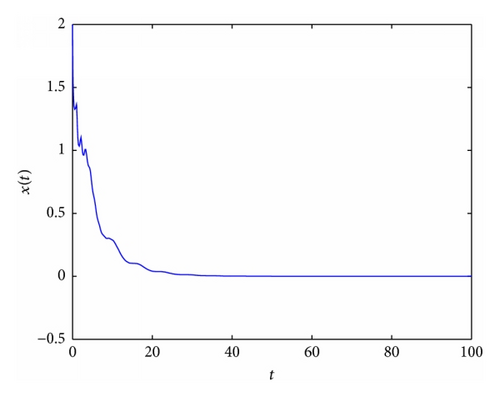
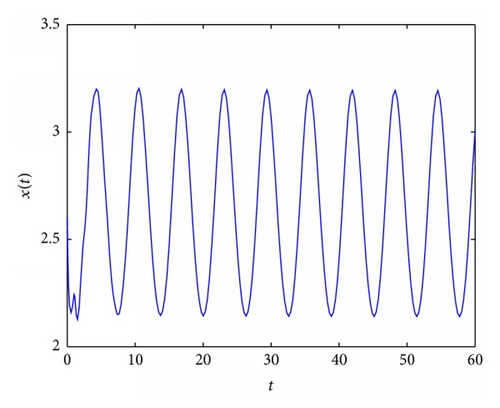
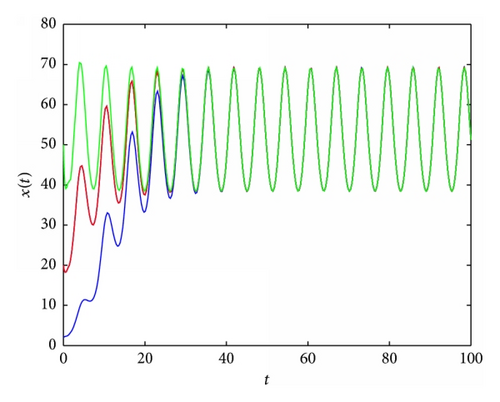
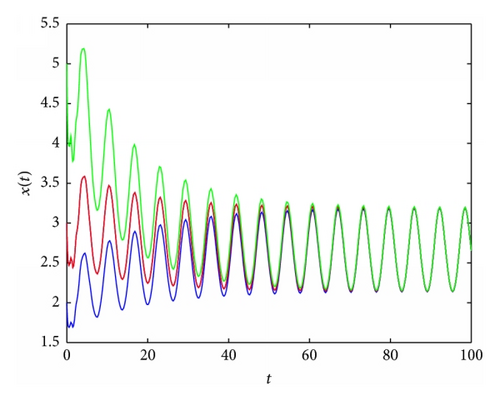
In Figure 2, an example of the behaviour of solutions in the case which is covered by Lemma 3(2) is presented. In Figures 3 and 5, it occurs that, for various values of parameters, the tumor will disappear. First (see Figure 3), an example of the behaviour of solutions in the case which is covered by Lemma 3(1) is presented. And then (see Figure 5), an example of the behaviour of solutions in the case which is covered by Theorem 4(ii) is presented. In Figure 4, an example of the behaviour of solutions in the case which is covered by Theorem 4(i) and Theorem 8 is given.
From Figure 6, we see that when , there exists a periodic solution. We conjecture that if , there exists at least one periodic solution to (11).
By Figures 7 and 8, we conjecture that the periodic solution is unique (if it exists) since, under different initial values, the solutions to (11) all tend to the periodic solution.
As being pointed out by a referee and we fully agree, the numerical simulations have limitations. Since we have no clinical data to compare with our results, the weaknesses of the numerical simulations are that we cannot use realistic parameter values to check whether the conditions for the existence of periodic solutions are biologically feasible and investigate (numerically) their amplitude. Further study on questions pointed out above and how we interpret them is needed.
Competing Interests
The authors declare that there are no competing interests regarding the publication of this paper.
Acknowledgments
The authors would like to thank the editor and the two referees for their very helpful and valuable suggestions on modification of the original manuscript. The work of the first author is partially supported by NNSF of China (11301474 and 11171295) and Foundation for Distinguished Young Teachers in Higher Education of Guangdong, China (Yq2013163). The third author is partially supported in part by NNSF of China (51508319, 61374195, and 51409157), the research program of the National Special Authorized Social Science Fund of China (07@ZH005), and the Nature and Science Fund from Zhejiang Province Ministry of Education (Y201327642).




